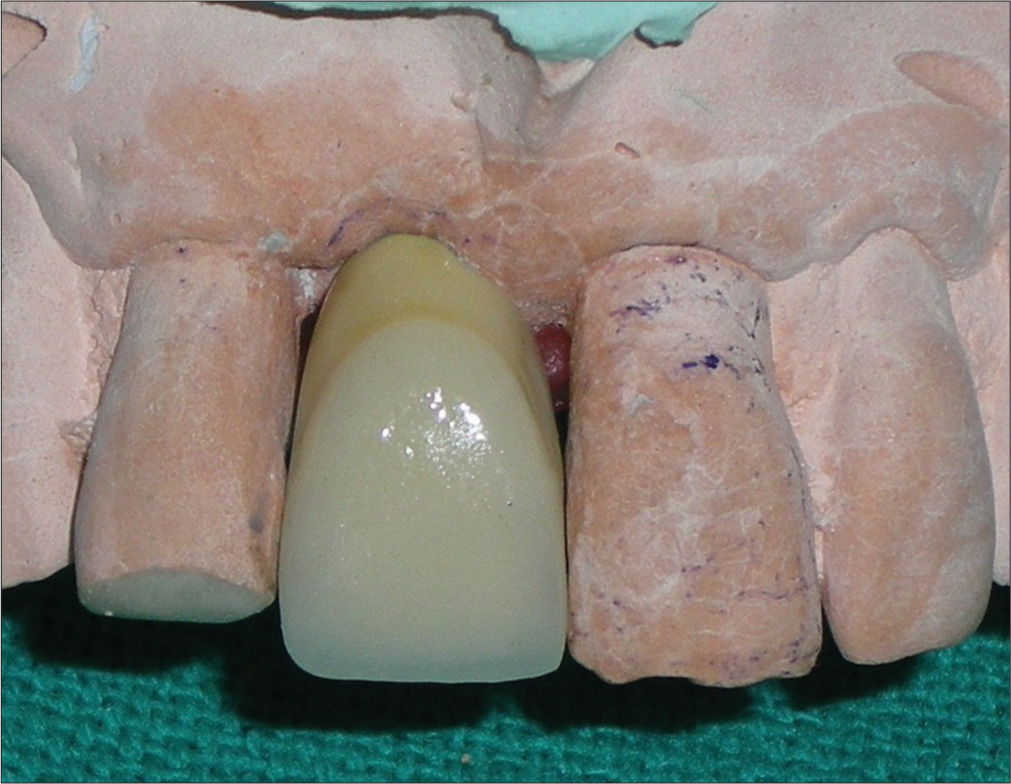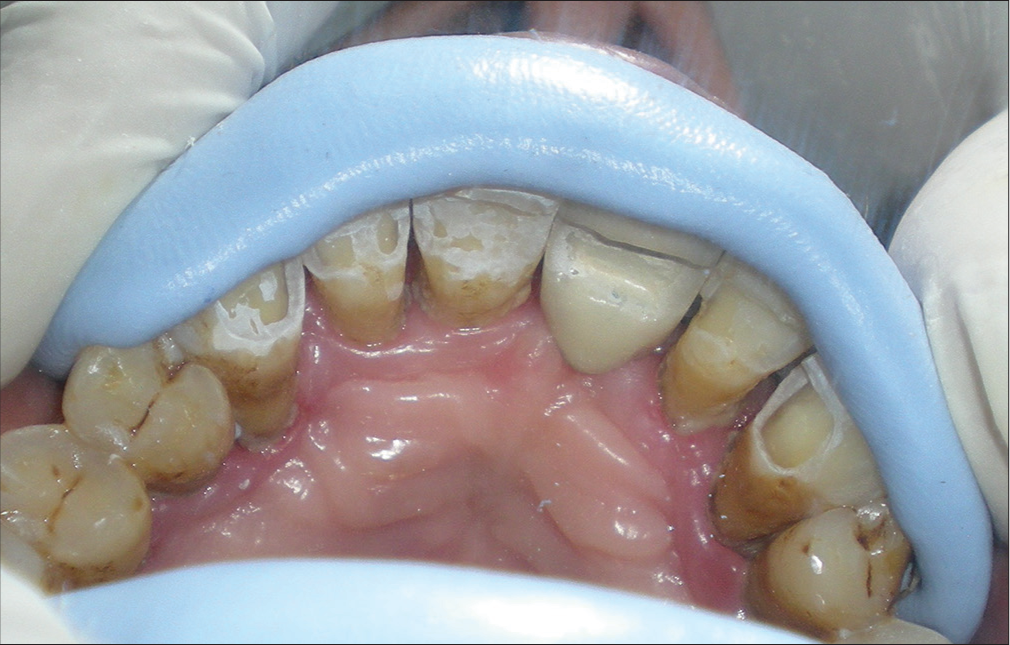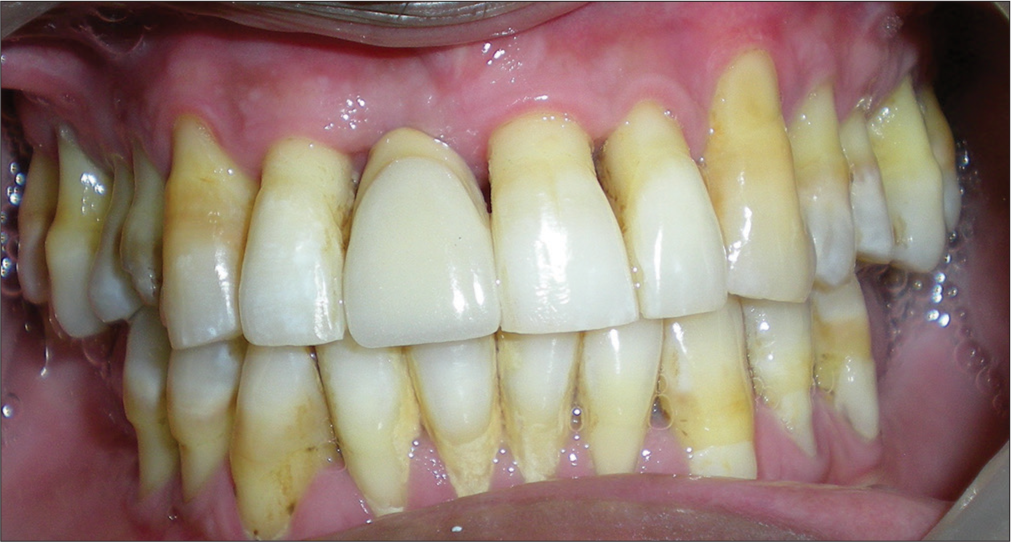Translate this page into:
Options for replacing a single lost anterior tooth in a dentition with reduced periodontal health

*Corresponding author: Dr. Akash Raj Sharma, Assistant Professor, Department of Prosthodontics and Crown and Bridge, Subharti Dental College and Hospital, Meerut, Uttar Pradesh, India. itsdocakash@gmail.com
-
Received: ,
Accepted: ,
How to cite this article: John ES, Sharma AR, Rawat P, Singh Y. Options for replacing a single lost anterior tooth in a dentition with reduced periodontal health. J Academy Dent Educ. 2024;10:122-6. doi: 10.25259/JADE_81_2023
Abstract
To restore comfort, function, and esthetics while maintaining occlusal stability, restoring a single missing anterior tooth in a periodontally impaired dentition is a significant task. An implant-supported crown, traditional three-unit fixed partial denture (FPD), cantilever FPD, resin-bonded FPD, or removable partial denture can be considered in a normal, healthy dentition; however, problems with mobility and poor periodontal support of the remaining dentition may make these procedures unfeasible options as it might be difficult to avoid overloading of the implant in periodontal compromised adjacent teeth, difficult to achieve proper esthetics with conventional FPD, to maintain the stability of dental arch with acrylic resin removable partial dentures is not possible and incidences of frequent debonding of resin bonded FPD are high when abutments are mobiles. Fiber-reinforced composite resin FPD is often effective in these clinical situations to provide a conservative therapy option to restore the patient’s ease and esthetics by limiting mobility.
Keywords
Fiber reinforced composite
Fixed partial denture
Periodontal problems
Implants
Missing anterior teeth
INTRODUCTION
The maxillary anterior region presents an even more difficult treatment strategy for a single lost anterior tooth than the other parts of the mouth. When the remaining teeth are movable and compromised by periodontal disease, it becomes more complicated. In periodontal-healthy conditions, there are a variety of treatment substitutes that can be taken into account for the restoration of a single lost anterior tooth, including implant-supported crowns and traditional three-unit fixed partial dentures (FPDs), cantilever FPDs, and detachable partial dentures made of acrylic resin, resin bonded FPD, and fiber reinforced composite resin FPD, but in case of abutments having mobility along with the gingival recession, careful selection of a specific treatment option should be done, keeping in mind the given clinical condition, ability of the prosthesis to restore form and function, expectancy of the longevity of the prosthesis, most common complication, and successful intraoral and extraoral treatment of complications.
In today’s commercial society, patients have grown to be demanding in choosing their treatment options. Providing a fixed replacement for a lost front tooth has always been challenging, especially for those who are unable to choose an implant or a traditional fixed prosthesis due to unfavorable clinical circumstances or a lack of monetary means. A conservative type of fixed prosthesis – the fiber-reinforced composite resin FPD, entirely based on enamel adhesion principles,[1] has become a treatment option. The fiber-reinforced composite resin fixed partial denture is made of an all-ceramic, porcelain fused to metal (PFM), composite resin, natural tooth, or acrylic resin pontic with a fiber reinforcements composite (FRC) foundation veneered with a composite material. Compared to all ceramic and PFM preparations, the bonding with composite resin pontic is less technique-sensitive, and horizontal palatal slots are simple to create. Bonding with composite resin pontic is less technique sensitive and preparation of horizontal palatal slots is easy in comparison to all ceramic and PFM preparations. Although the bonding to porcelain and metal is extremely technique-sensitive,[2] proper preparation of the palatal slot with no metal exposure and careful execution of the bonding technique can achieve better results.
The material’s mechanical properties are determined by the type of fiber, the fiber architecture, and the efficacy of the fiber/matrix interaction. According to laboratory tests, FRC materials have flexural strengths that are on par with or greater than those of metal alloys,[3] but they have a lower flexural modulus.[4] FRC a prosthesis, can be used to satisfactorily restore or replace teeth with fixed prostheses, according to clinical usage and research findings.[5,6] It can be considered as a viable alternative to restore esthetics and comfort and to stabilize the compromised dentition.
CASE REPORT
A 60-year-old man came to our dental facility complaining that his looks were unattractive due to a lost tooth that is the maxillary right central incisor and discomfort due to the mobility of three (central and lateral incisors) anterior teeth. The intraoral examination exhibited a periodontally impaired dentition with generalized bone loss, exposed tooth roots, bilaterally absent mandibular posterior teeth, and supra-erupted antagonists [Figure 1]. The patient was given a number of treatment choices based on the clinical and radiological results, including a standard FPD, a resin-bonded FPD, and a fiber-reinforced FPD with ceramic or composite resin pontic. Due to the mobility and periodontal damage of the adjacent teeth, an implant-supported crown was not considered. The patient chose not to give up his natural teeth; hence, the traditional FPD option was rejected. Although a resin-bonded FPD was less invasive than a typical FPD, the patient was concerned about the esthetics of the metal framework and how much of the palatal surface was involved in the placement of the abutments for the reta iners. Because it only needed two appointments and minimum tooth preparation on the palatal surfaces of abutment teeth, the patient decided on an fiber-reinforced composite fixed partial denture (FRCFPD) with PFM pontic.

- Missing right maxillary central incisor in a periodontally compromised dentition.
To develop a putty matrix, a PFM pontic was fabricated on the cast [Figure 2] to match the desired color and shape and was secured with wax applied to the palatal surface. This matrix was utilized to ensure that the pontic was positioned correctly intraorally during the direct production of the FRCFPD. A uniform mixture of putty (Aquasil soft putty/regular set, Dentsply Germany) was adapted to create the putty matrix. All anterior teeth’s labial surfaces should be covered by the matrix. The matrix was taken out of the cast, and the patient’s mouth was examined to determine how well it fit. Along with cotton rollers positioned in the buccal sulcus, a properly tailored matrix also aids in isolation. The palatal surface of the abutment teeth has horizontal grooves constructed in the middle (12, 13, 21, 22, and 23) on the same level. Five teeth were selected as abutments because 12, 21, and 22 had grade I mobility. For a splint to be effective, terminal abutments should have no clinical mobility and fiber-composite framework should be adapted in horizontal slots without any occlusal interferences. The correct positioning of the fiber framework in the grooves and a meticulous bonding process are essential for the retention of these FPD. When the fiber framework is correctly positioned in the grooves and the bonding technique is meticulously carried out, the incidences of debonding are reduced. After conditioning the grooves for 20 s with 37% phosphoric acid, they underwent a thorough water rinse. A bonding compound (Prime and Bond NT, Dentsply, Germany) was applied using a micro brush applicator after a mild drying period. The brush tip was used to scrape away any excess bonding agent before being gently dried and polymerized with light curing for 15 s each tooth.

- Porcelain fused metal pontic on working cast.
The PFM pontic was gently dried after being rinsed and etched for 60 s with 10% hydrofluoric acid. After that, a silane coupling agent was used for 60 s. The pontic was then held in proper position with the aid of the putty matrix [Figure 3] and all the etched palatal slots were partially filled with a composite resin of selected shade (Ceram X Duo, Dentsply, Germany) and then fiber was embedded properly in each groove. Following the removal of extra composite from the proximal embrasures, each abutment and pontic underwent 60 s of buccal and palatal surface polymerization. The use of the flowable composite over the fiber gave the palatal surface a smooth, glossy appearance [Figure 4]. The occlusion was assessed using articulating paper, and any early discrepancies were corrected by adjusting the prosthesis [Figure 5]. No debonding was observed throughout the 4-year follow-up, and the patient was satisfied with the result.

- Putty matrix used for stabilization of pontic intraorally.

- Palatal view of fiber reinforced composite fixed partial denture.

- Labial view of fiber reinforced composite fixed partial denture.
DISCUSSION
The patient’s wishes (to restore comfort, esthetics, reduce mobility of the mobile teeth, and involve the abutment teeth as little as possible) and the long-term outcome should be considered when carefully choosing the treatment modalities for the replacement of a single missing tooth in a periodontally compromised dentition. Under ideal circumstances, the implant-supported crown should be the initial option for replacing a lost maxillary anterior tooth. However, in periodontally compromised dentition where adjacent and remaining teeth are mobile, implants are not advisable due to poorer implant survival in patients with periodontal disease. The rigid implant crown is usually subjected to excessive load[7] as the mobile teeth move out of occlusion during function. In such cases, the rigid implant has to bear all the load in maximum intercuspation position and lateral excursions unless the occlusion on the implant crown is adjusted properly to distribute the occlusal forces to the natural teeth, which is difficult to achieve when teeth are mobile. Furthermore, mobile teeth require splinting to minimize discomfort due to the mobility of the teeth, which is not possible with a single implant crown.
When the remaining dentition is sound, a conventional bridge is the second most popular choice for replacing a single lost tooth. Although the FPD acts as a splint and stabilizes mobile teeth, when primary abutments (teeth adjacent to edentulous space) have grade 1 mobility, the fabrication of a FPD requires the involvement of additional teeth as abutments, which is not acceptable to most patients (replacement of single tooth in this case requires preparation of at least four or more natural teeth and also having concern about the form, shape, contours, shade, and final esthetics of the prosthesis) and desired to keep natural teeth intact nor is double abutting good practice.
A Cantilever Bridge is considered only when the maxillary lateral incisor is missing, limited mesiodistal space is available, and controlled less forces exert on the pontic and canine is periodontally sound, which is selected as the abutment due to its long, unique shape root, and large surface area. However, the overall prognosis is worse compared with a conventional three-unit fixed dental prosthesis. The most common mode of failure is frequent uncementation due to tensile and shear forces (luting cements are 10–20 times weaker to tensile forces in comparison to compressive forces). Therefore, the cantilever FPD is a strict no-no for the restoration of a lost tooth in a dentition with damaged periodontal tissues.
Bonded by resin if the abutments are healthy, intact, immobile, and have a limited edentulous span as well as little dynamic occlusal contacts on the abutment teeth, FPDs are a conservative treatment option with a high survival rate for the restoration of missing front teeth.[7,8] Despite favorable conditions, 30% debonding is often reported.[9,10] However, the chances of debonding further increases if the abutments are mobile (even slight difference in the mobility of abutments). Hence, resin-bonded FPD is not a good option for prosthetic rehabilitation in the clinical compromised dentition.
Single-tooth acrylic resin removable partial dentures usually lack retention and stability thereby, thereby increasing lateral/horizontal forces on the mobile teeth, resulting in a further increase in mobility and periodontal degradation. As a result, in dentition with impaired periodontal tissues it is not a practical alternative for tooth replacement. In addition, a detachable cast partial denture is infrequently used to repair a single missing tooth.
A flexible, removable partial denture with a flexible thermoplastic denture base was considered as a treatment option compared to an acrylic resin removable partial denture. However, the difficulty in controlling horizontal forces, which could further deteriorate the periodontal condition of the remaining involved teeth, ruled out this option as well.
In a periodontally compromised dentition, fiber-reinforced composite resin FPD is a good conservative treatment option to restore esthetics as well as to stabilize the remaining mobile teeth and also the incidence of debonding is very low. The quantity/type of fiber in the resin matrix and adherence to the abutments both affect how long FRCFPD will last.[11] The strength of the framework is significantly improved by adding carbon, glass, and polyethylene fiber to the resin matrix. This is likely because the fibers adhere to the resin more effectively.[12] The use of fibers increases flexural strength and fracture toughness and improves the success rate of the prosthesis due to the transfer of stress from the matrix to the fibers, which have higher tensile strength. The fatigue resistance of composite resin matrix reinforced with fibers was significantly higher than that reinforced with metal wires.[13] The use of fibers for reinforcement increases fracture resistance because they can stop a starting fracture from spreading through a prosthesis.[14] The quantity of fibers in the resin matrix, their orientation, their impregnation, and their adhesion to the resin matrix are some of the variables that have an impact on the strength of FRCFPD.[15,16]
The patient’s desires always affect treatment options.[17-19] Before beginning therapy, the patient must be given a thorough explanation of the anticipated outcomes as well as any potential dangers or consequences.
CONCLUSION
The rehabilitation of the prosthetic space in a periodontally damaged dentition is a special emphasis of this article’s discussion of the numerous treatment options taken into account for the replacement of a single missing anterior tooth. For this case, the FRCFPD was considered a better option to restore esthetics, comfort, and stabilize the mobile teeth by splinting the periodontally compromised teeth effectively. This technique is simple and least time consuming. However, it is highly operator-dependent and demands appropriate case selection.
Ethical approval
Institutional Review Board approval is not required.
Declaration of patient consent
Patient’s consent not required as patients identity is not disclosed or compromised.
Conflicts of interest
There are no conflicts of interest.
Use of artificial intelligence (AI)-assisted technology for manuscript preparation
The authors confirm that there was no use of artificial intelligence (AI)-assisted technology for assisting in the writing or editing of the manuscript and no images were manipulated using AI.
Financial support and sponsorship
Nil.
References
- Rehabilitation of periodontally compromised teeth with fiber-reinforced composite resin: A case report. Quintessence Int. 2011;42:113-20.
- [Google Scholar]
- Bond strength durability of a resin composite on a reinforced ceramic using various repair systems. Dent Mater. 2009;25:1477-83.
- [CrossRef] [Google Scholar]
- Phillips' science of dental materials (10th ed). Philadelphia, PA: WB Saunders; 1996. p. :431.
- [Google Scholar]
- Effect of design parameters on the flexural properties of fiber-reinforced composites. J Mater Sci Lett. 2000;19:663-5.
- [CrossRef] [Google Scholar]
- Preimpregnated, fiber-reinforced prostheses. Part I. Basic rationale and complete-coverage and intracoronal fixed partial denture designs. Quintessence Int. 1998;29:689-96.
- [Google Scholar]
- Clinical evaluation of fiber-reinforced fixed bridges. J Am Dent Assoc. 2002;133:1524-34.
- [CrossRef] [Google Scholar]
- Contemporary implant dentistry (3rd ed). United States: Mosby Elsevier; 2008. p. :343.
- [Google Scholar]
- Single tooth replacement using a modified metal-ceramic resin-bonded fixed partial denture: A clinical report. J Prosthet Dent. 2004;91:414-7.
- [CrossRef] [Google Scholar]
- Clinical results with resin-bonded prostheses and an adhesive cement. Quintessence Int. 1994;25:125-32.
- [Google Scholar]
- Ten-year clinical and microscopic evaluation of resin-bonded restorations. Quintessence Int. 1996;27:803-7.
- [Google Scholar]
- Comparison of the in vitro fatigue resistance of an acrylic resin removable partial denture reinforced with continuous glass fibers or metal wires. J Prosthodont. 1996;5:115-21.
- [CrossRef] [Google Scholar]
- Fracture resistance of fiber-reinforced PMMA interim fixed partial dentures. J Prosthodont. 2006;15:223-8.
- [CrossRef] [Google Scholar]
- The effect of placement and quantity of glass fibers on the fracture resistance of interim fixed partial dentures. Int J Prosthodont. 2000;13:72-8.
- [Google Scholar]
- Glass fiber reinforcement in repaired acrylic resin removable dentures: Preliminary results of a clinical study. Quintessence Int. 1997;28:39-44.
- [Google Scholar]
- In vitro resistance of reinforced interim fixed partial dentures. J Prosthet Dent. 2003;89:170-4.
- [CrossRef] [Google Scholar]
- Effect of glass-fiber reinforcement and water storage on fracture toughness (KIC) of polymer-based provisional crown and FPD materials. Int J Prosthodont. 2004;17:318-22.
- [Google Scholar]
- Occlusal indicators: It's not always red and blue. J Prosthodont Dent. 2020;15:11-21.
- [Google Scholar]
- A simplified method for evaluating optimized gingival contour for single implant supported zirconia crown in the aesthetic zone-an in vivo study. J Pharm Negat Results. 2022;13:12-9.
- [CrossRef] [Google Scholar]
- Clinical success of the fiber reinforced composite fixed partial denture (FRC FPD) in anterior region for missing one or two missing teeth in anterior region. An original study. J Pharm Negat Results. 2023;14:1856-66.
- [Google Scholar]






